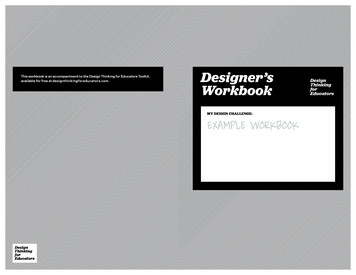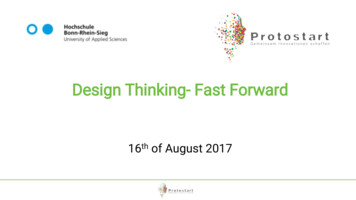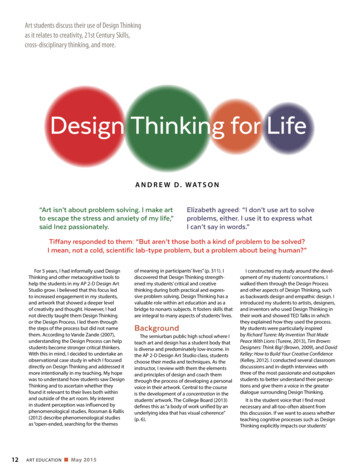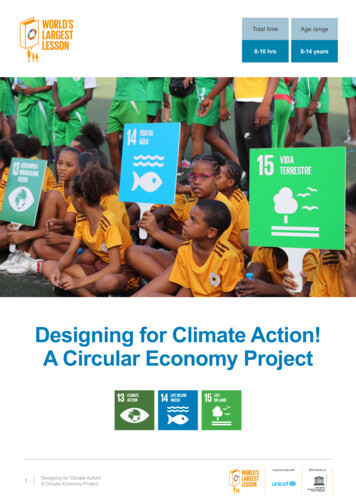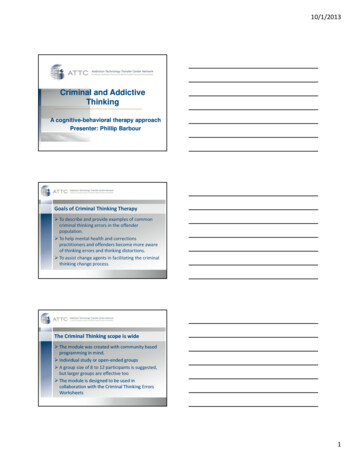
Transcription
BASICSDesign08DESIGNTH!NKINGnthe act or practiceof using your mind toconsider designGavin AmbrosePaul Harris
BASICSdesign08DESIGNTH!NKINGGavin AmbrosePaul Harris
An AVA BookPublished by AVA Publishing SARue des Fontenailles 16Case Postale1000 Lausanne 6SwitzerlandTel: 41 786 005 109Email: enquiries@avabooks.chDistributed by Thames & Hudson (ex-North America)181a High HolbornLondon WC1V 7QXUnited KingdomTel: 44 20 7845 5000Fax: 44 20 7845 5055Email: tributed in the USA & Canada by:Ingram Publisher Services Inc.1 Ingram Blvd.La Vergne TN 37086USATel: 1 866 400 5351Fax: 1 800 838 1149Email: h Language Support OfficeAVA Publishing (UK) Ltd.Tel: 44 1903 204 455Email: enquiries@avabooks.chCopyright AVA Publishing SA 2010All rights reserved. No part of this publication may be reproduced,stored in a retrieval system or transmitted in any form or by any means,electronic, mechanical, photocopying, recording or otherwise, withoutpermission of the copyright holder.ISBN 978-2-940411-17-710 9 8 7 6 5 4 3 2 1Design and text by Gavin Ambrose and Paul HarrisOriginal photography by Xavier Youngwww.xavieryoung.co.ukDesign ThinkingProduction by AVA Book Production Pte. Ltd., SingaporeTel: 65 6334 8173Fax: 65 6259 9830Email: production@avabooks.com.sgAll reasonable attempts have been made to trace, clear and credit thecopyright holders of the images reproduced in this book. However, if anycredits have been inadvertently omitted, the publisher will endeavour toincorporate amendments in future editions.
23Client: Futro FanzineDesign: FutroDesign thinking:Logo appropriation forcespeople to consider the parallelsbetween large corporationsFutro FanzineThis poster, created by Futro, appropriates a famous fast-food logo and adaptsit to the context of organised religion by making it appear like a church building orbishop’s mitre. The appropriation transfers the fast-food brand characteristics andcolour scheme to the new context and implies that organised religion is akin to amassive global brand with great marketing muscle. The design questions howpeople view both large corporations and religion.Design thinkingand religion
ContentsIntroductionHow to get the most out of this bookFrost DesignDesign Thinking ContentsStages of thinkingThe design processStage 1 – DefineStage 2 – ResearchStage 3 – IdeateStage 4 – PrototypeStage 5 – SelectStage 6 – ImplementStage 7 – LearnExample project68NB Studio10121418202224262830ResearchIdentifying driversInformation gatheringTarget groupsSamples andfeedbackStudio Myerscough3436384246Idea generationBasic designdirectionsThemes of thinkingInspiration resenting ideas485056606670747680
45Refinement82Thinking in images84Thinking in ual metaphors100Modification102Thinking in words108Words and language 110Type ‘faces’118Thinking in shapes 120Thinking inproportions124Thinking in colour 130Studio OutputPrototypingDeveloping designs‘Types’ of prototypeVocabularyPeter and ContactsWorking with 0192193Design Thinking ContentsFutro
Introduction‘You cannot hold a design in your hand. It is not a thing. It is a process. A system.A way of thinking.’Bob Gill, Graphic Design as a Second LanguageDesign is an iterative process and design thinking is present in each stageof the journey from client brief to finished work. Different solutions can beproduced for any given brief and these can differ widely in levels of creativity,practicality and budget.This book aims to present an overview of the design thinking involved at each stageof the design process: the methods used by designers to generate and refinecreative ideas, the key considerations that help shape them and the feedbackand review elements that allow design teams to learn from each job and contributeto future commissions.Design Thinking IntroductionThrough detailed studies of contemporary work and analysis of the basic theories, weexamine how a designer can generate and resolve ideas to produce creativesolutions that best meet the stated aims of a brief.Stages of thinkingRefinementAn overview of the different stages of the designThis section looks at how a general design conceptprocess and the key considerations of each stagecan be refined. We will examine how images, words,to produce a successful design, with a focus oncolour and substrates can be used to enhance the ideathe design brief and project definition stage.and increase its effectiveness.ResearchPrototypingThis section looks at the stage at which information isDesign ideas need to be presented and articulated tocollected to help generate design ideas. This includestest target group acceptance and receive clientconsumer profiles and target group definitions,approval. Here we see how models, dummies andquantitative and qualitative information andstoryboards can be used to convey ideas so that theyfeedback from past projects.can be understood in this context.Idea generationImplementationHere we look at how designers use different methodsThis section looks at how ideas come to life throughand sources of inspiration to generate creativeproduction. Implementation must ensure that designsolutions to the brief. These include sketching,details are put into effect and that the client is happybrainstorming and the different paradigms usedwith the final product.through design history.
67Client: Getty ImagesDesign: Gavin AmbroseDesign thinking: Choiceof photographs to echo themessage being conveyed byGetty ImagesThese cards were created by Gavin Ambrose to announce the upcoming officemove for the sports department at Getty Images. The images by Julian Herbert(top) and Mike Hewitt (bottom) depict dramatic movement, reflecting the physicalmovement of the company’s office. The cards also use humour; as one group ofanimals is running away, the other group is just arriving.Design thinking Introductionthe design
How to get the most out of this bookThis book introduces different aspects of design thinking via dedicatedchapters for each topic. Each chapter provides numerous examples fromleading contemporary design studios, showing unique and creative designthinking and with a detailed analysis to explain the reasons behind thedesign choices made.Key design principles are isolated so that the reader can see how they are appliedin practice.Clear navigationIntroductionsEach chapter has a clear strapline,Special section introductionswhich allows readers to quicklyoutline basic concepts that willlocate areas of interest.be discussed.Samples and feedback46 47Samples and feedbackUnderstanding the motivations,behaviours and aspirations of a targetgroup often involves detailed study of thatgroup. As it is not possible to quiz everymember of the target population, a samplegroup is typically defined.Client: London Collegeof FashionDesign: Moving BrandsDesign thinking: Interactivepresentation allows viewersto leave feedbackSamplesA sample group is typically a collection of five to ten people who share thecharacteristics of the target group and who can be used for one-to-oneinterviews, questionnaires and focus groups. The sample should be asrepresentative as possible of the overall population under study and should beselected by first determining the most important attributes that define the group.These may include age, education level, ethnicity and socio-economic group.Scoring methodsAll design ideas are to be scored against the individual selection criteria andthen these will be totalled to produce a final score for each idea.London College of FashionThe Looking Glass, London College of Fashion’s 2008 graduate exhibition,showcased the work of 600 students to an industry audience looking for futurestars. The ingenious design of the exhibition saw each student represented bya postcard-sized tag which, when placed on a custom-built responsive table,would activate an interactive projection of the student’s work on the tablesurface. The table interface was designed so that the viewer could control whosedigital portfolio of work was being shown via these tags. As such, through theirchoice of tags, the viewer provided explicit feedback about what they wanted tosee. The dark monochrome palette and mirroring effects underlined the ‘lookingglass’ theme that was intended to give a sense of transparency and intrigue.ExamplesCommercial projects fromcontemporary studios anddesigners bring to life theprinciples under discussion.Design Thinking Samples and feedbackCluster and vote, deciding which ideas to developThis is a method used to identify patterns in a problem area or in a series ofideas to help the design team select appropriate solutions. This system usesagreed assessment criteria that can take into account the concerns of multiplestakeholders. These criteria are brainstormed, refined, agreed and structuredto encourage participants to consider the perspectives of other stakeholders.Design Thinking ResearchDesign Thinking How to get the most out of this bookFeedbackDesign is an iterative process, during which internal and external feedback issought and received at all stages. The main learning opportunity comes at theend of the process when feedback about the performance, acceptance andsuccess of a design is sought and fed back into the design process. The aimof this is to maintain or improve performance or to better control the process.
89Basic design directions50 51Basic design directionsStarting from a given point (often thedesign of existing or competing products,brands or organisations), designers canthink in specific ‘directions’ in order togenerate new ideas from existing designs.Client: Ian Macleod DistillersDesign: NavyblueDesign thinking: A divergencefrom the typical traditionand heritage-based approachcreates an exciting andunique alternativeDivergenceDivergence is the expansion or spreading out of something from a central pointor theme. This can be clearly seen in fields as diverse as market segmentationand typography. Divergence occurs as both an instigator and a response todivergence in society at large as designers respond to changing demographics,and the increasingly diverse market segmentations of their clients.ConvergenceConvergence is the contraction of something towards a central, moregeneralised point. In design, although the overriding tendency is towardsdivergence, convergence can still be found in areas such as generic branding.Brands nowadays often take products back to a more basic state or prebranding time – when a tin of tomatoes was just a tin of tomatoes, for example.DiagramsDiagrams add meaning toTransformationTransformation involves a substantial qualitative change, such as the redesign ofa visual identity, or a repackage in order to facilitate a new distribution method.theory by showing the basicDivergenceConvergenceTransformationMoving away in differentThe coming together of two orA qualitative change indirections from a common point.more entities towards a centralappearance or character.Also called branching out.point or common ground.Ian Macleod DistillersIn its redesign of the packaging for Ian Macleod Distillers’ Smokehead Scotch whisky,Navyblue took a divergent approach. Using the traditional approach to branding forScotch whisky as a starting point, Navyblue branched out to create an unusual andunique design. Thus, instead of taking a history- and tradition-based approach to thepackaging, it produced a young and energetic image, focusing on the inherentqualities and flavours found within the product.Thinking in imagesDesign Thinking Basic design directionsDesign Thinking Idea generationprinciples in action.84 85Thinking in imagesImages have the ability to convey an ideaor a lot of information very quickly, whichis why images are such a prominent partof graphic design. As we all know, apicture paints a thousand words, so it isworth spending adequate time on imageselection and presentation.Client: Trafalgar HotelDesign: Social DesignDesign thinking: Imagesrepresenting aspects of hotelservices are used as icons tocreate patternsReceiving and interpreting imagesWhat this means in practice is that one cannot just show a picture of a house. The designer must thinkabout other design aspects that will condition how the viewer receives or interprets the image of the house.Trafalgar HotelPictured are print pieces created by Social for a rebrand of the Trafalgar Hotelin London. The designs feature patterns made up of icons that represent differentaspects of the hotel’s service. For example, a glass pattern is used for thedrinks menu and a balloon whisk for the food menu. Within the context of aretail environment, the use of patterns softens the dining experience and createsa point of interest.Does the house represent an Englishman’s castle, a home, an architectural work, a source of joy or sorrow?Additional informationCaptionsClients, designers and the designKey points are explainedthinking used are included here.within the context of anexample project.Design thinking How to get the most out of this bookDesign Thinking RefinementImages can be used to communicate in many different ways as they are veryversatile and their reading can be conditioned by other factors at play duringtheir presentation. Images can have different cultural and social interpretationsand these can be shaped by the contexts within which they are used.The cultural groups they are directed towards, the inclusion or exclusion ofparticular signs and symbols shared by a cultural group, the use or absenceof conditioning agents such as wit and humour and appropriation of historicalmeaning, are all factors that might influence the meaning drawn from an image.The way an image or design is rendered also has an impact; a black-and-whitesketch conveys a different feel from a glossy print, for example.
Stages of thinking
10 11Stages of thinkingDesign is a process that turns a brief or requirement into afinished product or design solution. The design process canbe said to comprise seven stages: define, research, ideate,prototype, select, implement and learn. Each of these requiresdesign thinking. This chapter will outline each of the seven stagesand the design thinking aspects they entail, while subsequentchapters will look at specific stages of the process in more detail.The design process engages a high degree of creativity but in a waythat is controlled and directed by the process so that it is channelledtowards producing a viable, practical solution to the design problem,meeting or excelling the stated aims of the brief.While creativity in design is important, design is an activity that serveseconomic as well as creative goals. The design process helps ensurethat a design satisfies all such considerations. The process seeksto generate a number of possible solutions and utilises varioustechniques or mechanisms that encourage participants to thinkoutside the box in the pursuit of creative or innovative solutions.The creative studio (facing page)These images depict Studio Myerscough’s design studio in London, UK.The space facilitates creative thinking and presents an organised chaos, ladenwith stimuli, and more ordered than it might first appear. The walls are usedto thematically collate research and meeting zones are informal, facilitatingbrainstorming and working space. The space is flexible and adaptable and canbe filled and refreshed to help the design thinking process continue its cycle.
The design processThe design processWithin the design process, seven stepscan be identified: define, research,ideate, prototype, select, implementand learn.First, the design problem and the target audience needs to be defined. A preciseunderstanding of the problem and its constraints allows more exact solutionsto be developed. This stage determines what is necessary for the project to besuccessful. The research stage reviews information such as the history of thedesign problem, end-user research and opinion-led interviews, and identifiespotential obstacles.Ideate is the stage where end-user motivations and needs are identifiedand ideas are generated to meet these, perhaps through brainstorming.Prototyping sees the resolve or working-up of these ideas, which are presentedfor user-group and stakeholder review, prior to being presented to the client.Selection sees the proposed solutions reviewed against the design briefobjective. Some solutions might be practical but may not be the best ones.Implementation sees design development and its final delivery to the client.Learning helps designers improve their performance and, for this reason,designers should seek client and target audience feedback and determine ifthe solution met the goals of the brief. This may identify improvements thatcan be made in the future.Design Thinking Stages of thinkingWhile the design process is often linear, as shown below, it frequently involvesrevisiting earlier segments for reworking as it evolves.The seven stages of arnFeedback
12 13Client: Christie’sDesign: Studio AS/Gavin AmbroseDesign thinking: Unusualapproach to catalogue design,resulting from research,Christie’sThis catalogue was created for an auction of Princess Margaret’s (QueenElizabeth II’s younger sister) estate. Photographs of the princess wearing itemsof jewellery that are to be auctioned are displayed alongside photographs ofthe pieces themselves. Where possible, the pieces are shown at actual size.This level of detail challenges the norm in catalogue listings and came aboutas a result of research, prototyping and accumulated experience fromproducing catalogues.Design Thinking The design processprototyping and experience
Stage 1 – DefineStage 1 – DefineEstablishing what the problem is.This is the first stage in any design process and almost always involvesgenerating or receiving a design brief.The briefA design brief presents the client’s requirements for a job. These may be verbalor written, simple or complex. A brief contains a specific goal that is to be met bythe design but it may also be couched in terms that have varying interpretations.A brief may be as basic as ‘we need a brochure that makes us appeal to20–30-year-olds’ or ‘we need a brochure that makes us appear cool and stylish’.As a working relationship develops between a designer and a client over severaljobs, a greater understanding of what key terms mean is obtained. A designerneeds to interpret the brief and define what words such as ‘stylish’ and ‘cool’mean. This ensures that both parties have shared expectations. This may involvequestioning the validity of the brief’s elements. For example, a brochure mightnot be the best way to reach out and appeal to 20–30-year-olds, and perhapsan online campaign would be more effective?Writing and re-writing a briefClients have varying experiences of design services. For this reason, the qualityof the briefs that they provide will also vary. A brief needs to include anythingthat will allow the design team to initiate the design process. However, if it isnot robust enough, it may need to be rewritten and reworked with the client.Design Thinking Stages of thinkingChecklist:Do you understand what the client is asking for?Does the client understand what they are asking for?Do you agree on the definition of terms?Does the brief have any flaws?Can you manage client expectations?The first stage is to define the problem ryLearnFeedback
14 15EmóticaThis design brief was given to design studio Emotica by Continental Gold, aColombian gold exploration company. Emotica was asked to produce a newvisual identity for use on all the client’s external communications.Aim: To produce a new corporate identity thatreflects the exciting potential of this juniormining exploration company. To create an identity that resonates withpotential investors as the company preparesto raise its profile ahead of an IPO.To differentiate the company from other miningcompanies, other gold companies, and othercompanies on the stock market in general.Who: the activity the client andtarget audience is active in.Why: to create a coherentvisual identity/advance aims.What: a corporate visualidentity to attract investors.Usage: The identity will be used on all externalcorporate communications including website,printed materials, business cards andpresentations.Geographical locations: The target audiencemainly reside in North America and Europe.Where: on all printand web-based externalcommunications.Target audience: Shareholders, bank analysts,media and other interested parties.Identity keys that relate to the nature of thecompany:Who: to attract new andexisting business interest.Nouns: Colombia, gold, mining, exploration,Antioquia, historyAdjectives: unique, new, exciting potential,impressive, experiencedDescriptors or keys:nouns, verbs and attributesthat can be used tocreate the unique sellingproposition the designpresents.Resulting identity: thewords ‘gold’ and ‘Colombia’are picked out to highlightthe USP of its business: goldin Colombia. The dark greenachieves high contrast andreflects Colombia’s climate.Design Thinking Stage 1 – DefineColours: gold, bright forest green,(Colombian flag colours: red, blue, yellow)
Stage 1 – DefineObjectivesObjectives are simply what the client hopes to achieve through commissioninga design job, and it is important that these are fully understood and ‘mapped’to your design thinking.Objectives need to be specified so that the design team knows what it has toachieve. Asking the client simple questions gets to the heart of the matter andfocuses on what the client expects, what the project boundaries are and whatdeliverables are required.Design Thinking Stages of thinking‘The Five Ws’ (borrowed from news writing), refers to five words beginning with‘w’, which, when asked, elicit factual answers that are necessary to adequatelydefine a design job. They are: who, what, when, where and why (‘how’ is oftentacked on to the end too). Asking questions such as these provides detail thatthe design team can use throughout the design process and identifies keyrestraints that they have to work to.1 Who is the client and target audience?(size, nature, characteristics)2 What design solution is the clientthinking of? (print, web, video)3 When will the design be needed and forhow long? (project timescales)4 Where will the design be used?(media, location, country)5 Why does the client think a designsolution is required? How will the solution be implemented?(budget, distribution, campaign)
16 17The propositionDefinition of the design brief and its objectives should enable the design teamto establish the general proposition of a design. The proposition can be usedto describe the general ideas and values that a design intends to present to,and be internalised by, the target audience. Once the proposition has beendetermined it can be more precisely defined and articulated to the audience.For example, an electrical manufacturer produces electrical goods, but sodo many other companies. This particular manufacturer’s values include beingreliable and giving quality service. Again, this is not unique. The propositionneeds to go beyond simply ‘what’ someone does. By spending time thinkingabout the proposition of a design, subsequent design thinking time will befocused and meaningful.PropositionValuesThe USP, or point of differenceHaving a clear understanding of the product, values and the proposition will inform your thinking at eachstage of the thinking process, and aligning these three facets will ensure a targeted delivery of an idea.Design Thinking Stage 1 – DefineProduct
Stage 2 – ResearchStage 2 – ResearchCollecting background information.Once the brief has been defined and agreed, a designer starts to search forinformation that can be fed into the creative process at the ideate stage. Thisresearch can be either quantitative, with hard statistical numbers about thesize and composition of target user groups, or qualitative, with informationabout what that user group buys or consumes and what their lifestyle is like.It may be pertinent to build a mental model of a typical user in order to enablethe design team to obtain a good feel for what would appeal to them. Thisincludes factors such as education, career, holiday destinations, musicaltastes, aspirations and so on.Primary researchA primary source of research is the feedback generated during the learningphase of projects previously undertaken with the same or similar clients. Suchfeedback provides a starting point with regard to what worked and what didnot work with a specific target group.Secondary researchSecondary research is the information obtained from general secondary sourcessuch as consumer market research reports. These provide the demographicbreakdown and historic performance of given markets and market segments,and provide a clear view of how a market is structured.Design Thinking Stages of thinkingChecklistDo you have feedback from previous projects?Do you have a statistical composition of the user group?Do you understand the target market?What is the education level of the user group?What is the typical lifestyle of the user group?What are the aspirations of the user group?The second stage sees a period of LearnFeedback
Ideas boardsThese ideas boards were compiled by design studio The Team, for four different projects. Competitorinformation and references from other sectors and markets are collated, together with material fromreference books and magazines, to give a broad background of the projects’ ‘topographies’ orlandscapes. All of this information will be fed back into the design process at the ideate stage.Design Thinking Stage 2 – Research18 19
Stage 3 – IdeateStage 3 – IdeateCreating potential solutions.During the ideate stage, the design team draws on the research gathered andthe constraints established during the define stage. This information is usedto create ideas with which to tackle the design brief.Designers use different methods to ideate, some of which will be discussedin more detail in chapter 3, ‘Idea generation’. Ideation methods includebrainstorming, sketching ideas, adapting a tried-and-tested design that alreadyexists, taking a top-down analytical approach that focuses on the product,service or company or a bottom-up approach that focuses on the customer oruser (both are further explained on page 56). Each method involves a varyingdegree of creativity and choosing which method to use will depend on factorssuch as how much money is available and how original the design needs to be.At this stage, a design team might also choose to harness one of themultitude of art and design movements or paradigms. A design brief can begiven a modernist, abstract, constructivist or a deconstructivist interpretation,for example.As the ideate stage progresses, it will become clear whether there are anymisunderstandings or shortcomings in the definition stage and whether sufficientlevels of research were carried out. Feedback can be sought throughout thedesign process to clarify points of doubt with the client and to address aspectsthat were ill-defined during the definition stage.Design Thinking Stages of thinkingChecklist:Do you understand the brief?Do you have sufficient research information?Which methods will be used for idea generation?During the ideate stage, design ideas are yLearnFeedback
20 21Client: Barbican Art GalleryDesign: Research StudiosDesign thinking: Ideas foran initial design conceptgenerated through visualBarbican Art GalleryThese are some of the initial design concepts generated by Research Studiosfor an Anish Kapoor show at the Barbican in London. Time has been spentexperimenting or visually brainstorming, setting the artist’s name in varioustypefaces to create different visual statements. This experimental time can proveinvaluable, allowing your mind to wander, and your hand to ‘doodle’. This periodallows for experimentation, without considering what is ‘right’ or ‘wrong’,rejecting preconceptions in favour of free-thinking.Design Thinking Stage 3 – Ideatebrainstorming
Stage 4 – PrototypeStage 4 – PrototypeResolving solutions.The ideate stage generates a variety of potential solutions to the design brief.Prior to selection, it may be necessary to further work up the most promisingof these solutions. This will allow particular aspects to be tested and will providea better basis for comparison at the selection stage. In such cases a prototypecan be created.A prototype can be used to test the technical feasibility of a design idea to seeif it works as a physical object. Novel packaging or presentation ideas normallyrequire the development of a prototype. A prototype can also test the visualaspects of the design by presenting them as they would be produced. This alsoprovides the opportunity to test, where pertinent, a design in three dimensions.A prototype gives the design team and client the ability to visualise and handlea design concept, to get an idea of its physical presence and tactile qualities.As a prototype aims to test particular aspects of a design solution, it mustbe made so that those aspects are present and can be effectively evaluated.To convey the idea of what it will look like, a prototype does not need to bemade w
Design DESIGN TH!NKING BASICS 08 Gavin Ambrose Design Paul Harris n the act or practice of using your mind to consider design DESIGN TH!NKING Ethical practice is well known, taught and discussed in the domains of medicine, law, science and sociology but was, until recently, rarely discussed in the terms of th

